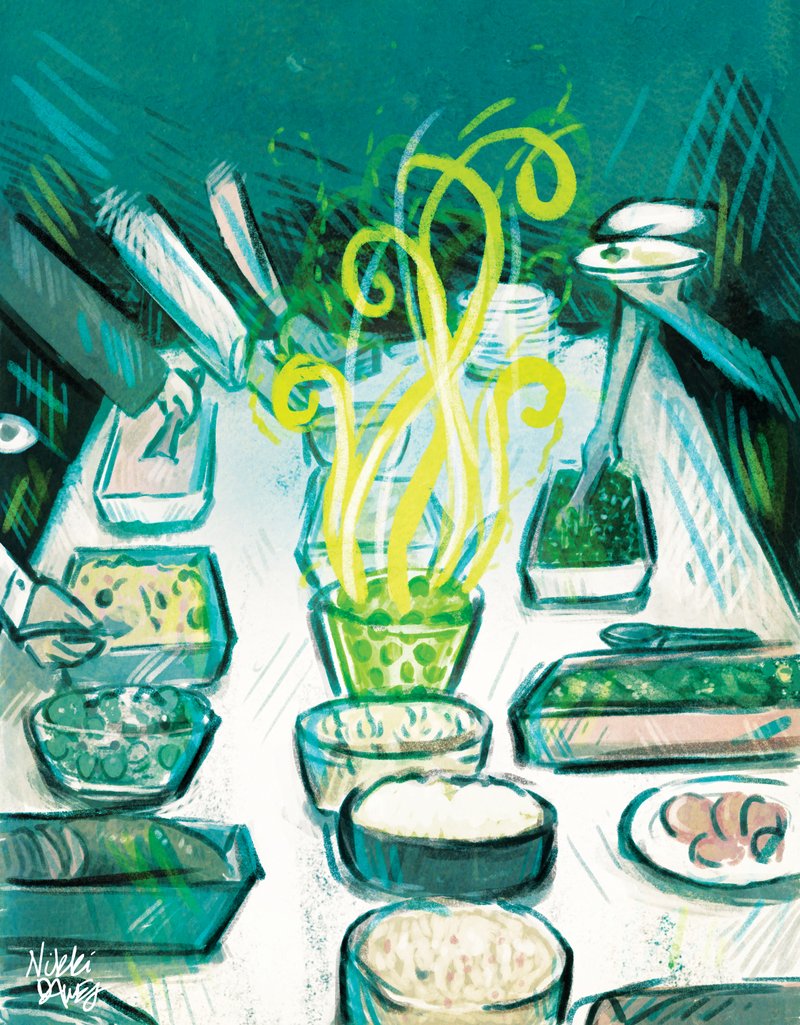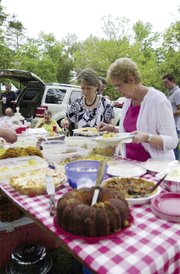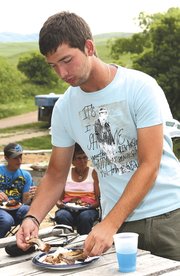Ah, the potluck -- that beloved tradition of church fellowship. Just the thought conjures up images of tables filled with prized family dishes like chicken spaghetti, broccoli and cheese casserole and scrumptious cakes and pies of all types.
But that mayonnaise-laden potato salad and crispy fried chicken can also be a breeding ground for bacteria. According to the Centers for Disease Control and Prevention, roughly 48 million Americans get sick and about 3,000 die each year from eating food that's either been contaminated or not properly prepared.
One person died and more than 20 were sickened in April at a potluck at Cross Pointe Free Will Baptist Church in Lancaster, Ohio. Potato salad made with home-canned potatoes contaminated with botulism was the culprit. The FDA says botulism can be caused by eating improperly canned foods, especially home-canned vegetables.
Some of the most common food-borne illnesses, according to the CDC, are campylobacter, listeria, E. coli, salmonella and shigella. Common causes are under-cooked meats, unpasteurized milk or juice and contaminated water, fruits or vegetables.
Potato or macaroni salad or anything made with mayonnaise is often the first suspect when a food-borne illness strikes, but food specialists say the cause can often be traced to poor hygiene or cross-contamination back home in the kitchen.
Brian Sparks is the chef at St. Paul's Episcopal Church in Fayetteville, where he prepares Sunday morning breakfasts and Wednesday evening meals for parishioners. He said food safety begins even before the cooking starts and stresses the importance of hand washing before handling food and also after handling raw meat and poultry.
"It's very, very important because cross-contamination can happen," he said.
Sparks said a cutting board used for meat should be washed before it's used for cutting fruit or vegetables. He also suggests washing produce before cutting it to prevent the spread of bacteria. Cutting an unwashed watermelon or cantaloupe, for example, can drag dirt and bacteria into the fruit along the blade of the knife.
One of the most important things to pay attention to is the "danger zone" of temperature, Sparks said.
"There's a range of temperature above 40 degrees to 140 degrees and it's called the danger zone of cooking," he said.
That means cold food should be kept at 40 degrees or below, while hot food should be 140 or above. Anything in between allows for the growth of bacteria.
At a potluck or picnic, he said, "There's got to be a way of keeping the hot foods hot and the cold foods cold."
"If you bring a potato salad, make sure it's in a tub of ice and it's advisable not to let it be in the sun," Sparks said. "Put it in the shade on ice."
Sparks said dishes with mayonnaise in particular should be kept on ice and not be left out more than two hours, and if the outside temperature is 90 degrees or more the window of safety falls to one hour.
Chafing dishes, steam tables or slow cookers can be used to keep hot food at a safe temperature.
While cooking, Sparks said, cooks need to pay attention to the proper minimum temperature for beef, pork and poultry. That's 145 degrees minimum for beef (not ground beef, which is 160 degrees), veal, lamb and pork. Chicken and turkey should be cooked to a minimum temperature of 165 degrees.
When cooking meat, it's also important to use one set of utensils and dishes for the raw product and another set for when it's fully cooked. Otherwise cross-contamination can occur.
Sage Arnold has been working in food service at Second Presbyterian Church in Little Rock for 23 years. She cooks meals for various events at the church, including luncheons, ministry nights and group meetings. She suggests avoiding mayonnaise-based items for potlucks and picnics and using dishes that use oil and vinegar for dressing instead. She said individual packets of shelf-stable mayo that don't need to be refrigerated can be used for sandwiches and other items instead of preparing a dish with it ahead of time.
"The very last thing I make is salad with salad dressing," she said.
Arnold said she would also avoid home-canned goods.
Like Sparks, she also said cross-contamination can be a big problem.
"It's always good to wash your hand and not necessarily use hand sanitizer. Wash at least 20 seconds and then don't touch anything until you dry them," she said. "Use hot soapy water."
Teresa Henson, a regional program associate at the Pulaski County Cooperative Extension Office, said the biggest causes of food-borne illness come from buying food from unsafe sources, failing to cook food correctly, holding food at incorrect temperatures, using contaminated equipment and practicing poor personal hygiene.
She said those preparing food should follow these steps -- clean, separate, cook and chill. That means wash hands and surfaces often, separate raw meats from other foods, cook foods to the right temperature and refrigerate foods promptly.
The Rev. Mary Hilliard, senior pastor of Asbury United Methodist Church in Little Rock, said food safety is always a concern when planning for church events that involve food, including potlucks, pancake fundraisers and barbecue cook-offs.
"It's come to the forefront of our minds," she said.
Hilliard said sharing a meal is a deep part of the Christian heritage.
"In the days of Christ, in the Jewish culture, to share a meal was a pact of friendship and so that's really something that's deep within our Christian roots," she said. "Food was not as common a commodity as we have now so it was seen as sacrificial, as well as giving the greatest hospitality."
Sharing a meal also has ties to Holy Communion.
"Jesus became the final host and his body and blood gave the meal," she said. "So it's richly tied and connected to who we are as a people of faith."
By following basic food safety rules, church members can share in food and fellowship without fear.
Information on food safety is available online at foodsafety.gov.
Religion on 07/18/2015



